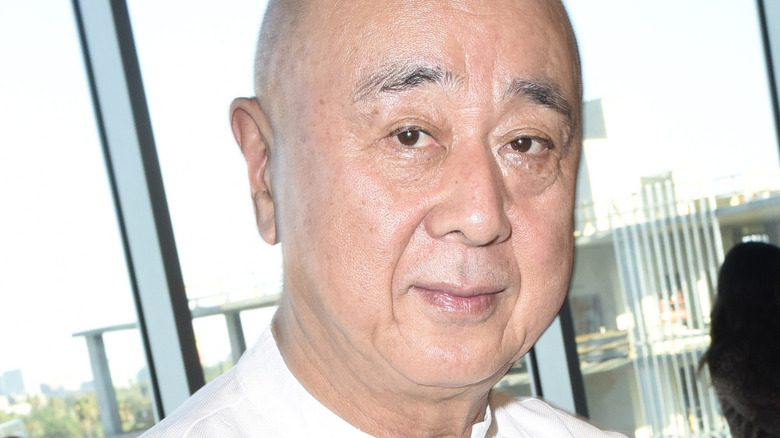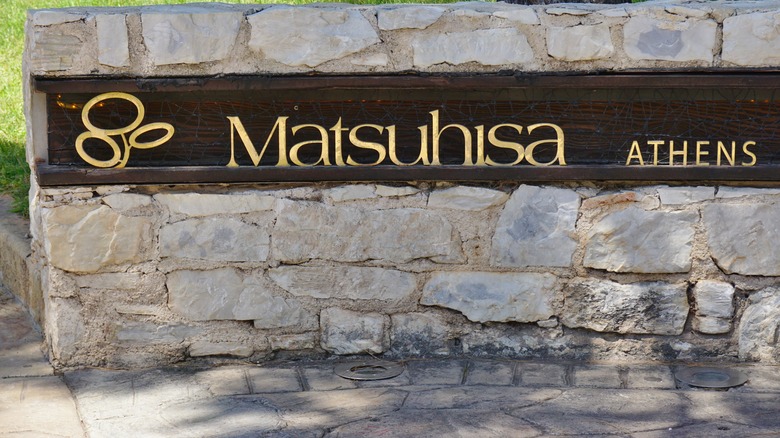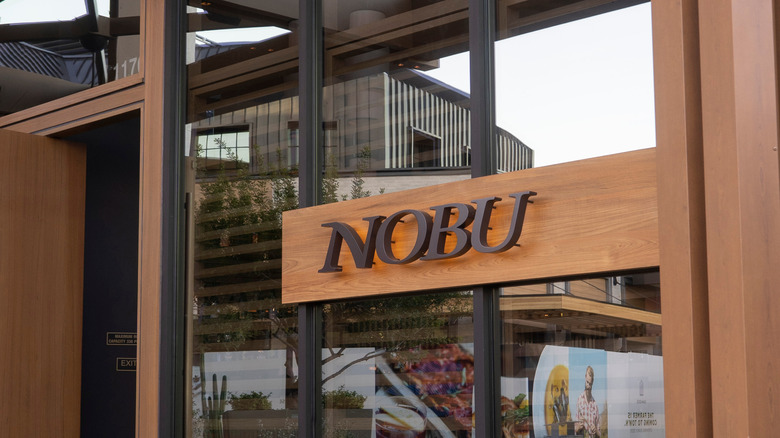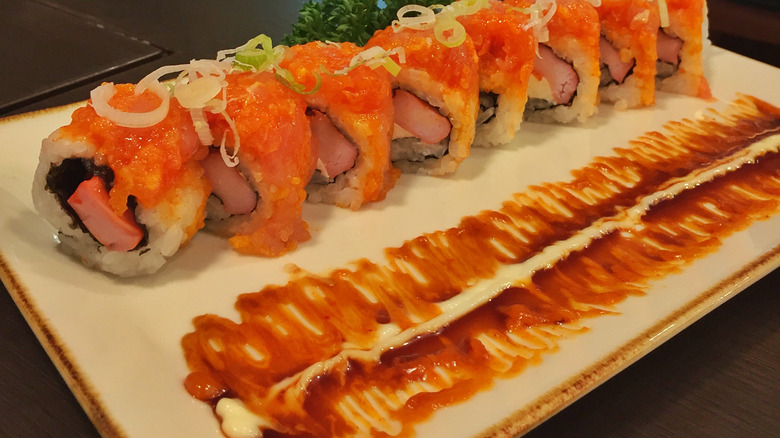Nobu Vs. Matsuhisa Restaurants: What's The Biggest Difference?
Like many legends of film, art, and culture, Nobu only needs one name to evoke his indelible mark on culinary America. Japanese by birth and training, Nobuyuki Matsuhisa left Japan for Peru in his early twenties to share his Japanese culinary technique while exploring the incredible flavors of South American cuisine. In the early 1970s, Matsuhisa opened his first restaurant in the United States in Anchorage, Alaska, per StarChefs, and it burned to the ground within weeks of opening. He moved to Los Angeles and, by 1977, was working in the city's top Japanese restaurants. The seasoned chef opened his eponymous restaurant, Matsuhisa, in 1987, and it became a favorite of gourmands and celebrities, including Robert De Niro. According to Haute Living, the legendary actor pushed Matsuhisa to open the first Nobu restaurant in Tribeca, New York City, in 1994.
Winning the James Beard award for the best new restaurant in 1995, Matsuhisa was primed for international stardom, according to StarChefs. Matsuhisa has developed a luxury lifestyle hospitality empire, including a chain of 15 luxury boutique hotels and 65 restaurants in the world's most glorious cities, via Haute Living. Multifariously talented, he has authored seven books, including a memoir and several cookbooks. Matsuhisa has the style and swagger of a film star, which he is, having appeared in three films: Casino, Memoirs of a Geisha, and Austin Powers Goldmember, IMDb reports. Throughout his successes and failures, Matsuhisa remains a generous mentor and humanitarian with a strong charitable giving plan.
Matsuhisa restaurants
Nobuyuki Matsuhisa owns eleven Matsuhisa restaurants. Four are in the United States: three in Colorado, one in Beverly Hills, and seven are scattered across Europe. Matsuhisa restaurants are expensive with an exclusive vibe. With dusky lighting and luxurious décor, these restaurants exude a plush aesthetic perfect for celebrations and romantic rendezvous. Expect to find Chef Nobu's specialties at Matsuhisa, including his take on black cod and miso, sashimi embellished with Peruvian and local ingredients like spicy peppers, aromatic herbs, and hints of fragrant umami courtesy of imported truffles.
The menu for sushi, maki, sashimi, nigiri, and tempura is extended here, offering classic selections alongside innovative dishes. Uncommon in traditional Japanese cuisine, filet mignon, free-range chicken, and lamb chops are found alongside fresh and saltwater fish, crustaceans, and sea and land vegetables. Matsuhisa boasts an extensive beverage list of the finest wines, spirits, saké, and beer. Its Aspen restaurant has an impressive 37-page beverage menu, a vibrant by-the-glass program, and exclusive wines from across the globe, including a rare $24,000 Domaine de la Romanée-Conti red Burgundy.
Nobu restaurants
Fundamentally, Nobu restaurants have a casual approach to fine dining since the focus is on the food. According to Forbes, each of the 54 locations has relaxed dress codes and an unfussy yet striking décor. Nobu menus highlight classic dishes and local creations meant to be shared. Select the seven-course omakase from the traditional menu for a historic Japanese cuisine culinary tour. Per Forbes, the servers are trained to suggest dishes that complement each other, ensuring each guest has the ultimate dining experience.
Opt for the Nobu Now menu for something modern infused with local and western flavors; it is where the master chef's creativity shines. Twists like yuzu truffle honey glaze drizzled over a grilled ribeye steak, jalapeno salsa, and seafood street tacos make Nobu stand out. Nobu desserts are more than mochi. Think buttermilk doughnuts sprinkled with cinnamon, a whisky cappuccino, monk fruit cheesecake, and a bento box filled with gelato and chocolates. Casual doesn't mean cheap or boring. Nobu restaurants are the only place in the world with exorbitantly expensive Hokusetsu saké, an ultra-high-quality daiginjos-style that is exclusive at the restaurants, via Forbes.
Matsuhisa versus Nobu, what are the differences?
According to Forbes, Nobu and Matsuhisa restaurants adhere to Nobu's philosophy of excellence focusing 50% on stellar service and 50% on food quality. Both play with Peruvian influences like seafood ceviches and tiraditos, a thinly sliced raw fish similar to sashimi or Crudo carpaccio. The restaurants also integrate local flavors into their seasonal dishes and specials and have exceptional beverage lists.
The concepts differ in ambiance and approach. "Matsuhisa restaurants are different to Nobu restaurants in that they are smaller, more intimate, and more upscale, but the concept of the food, the mix between Japanese and Latin American cuisine, is the same," Nobu Matsuhisa explains to Forbes. So, essentially, Matsuhisa restaurants are posh and more formal, with a sense of exclusivity reminiscent of a private club. Nobu restaurants, on the other hand, are open and bright, with visible kitchens and sushi counters buzzing with chefs and guests.
Chef Nobu's signature creations feature on both menus, but they are arranged and served differently. Nobu's early days in Peru are embedded in his technique and culinary creativity. "It's not Nikkei or fusion," he insists to Forbes. "It's Nobu style. It means that the cooking is still Japanese but with some ingredients and styles from Peru like cilantro, jalapeno peppers and ceviche. But I wouldn't say it's a fusion." Chef Nobu Matsuhisa says, "The restaurants and hotels that bear my name, Nobu, are considered high-end, but they're not exclusive. I want Nobu to bring smiles to our guests' faces with the bite of food, to give them a place to relax, enjoy good conversation over, a great meal and leave happy," via Nobu Hotels.



